Numerical Simulation of the Smoke Distribution Characteristics in a T-Shaped Roadway
Abstract
:1. Introduction
2. Simulation Methods
2.1. Physical Model
2.2. Boundary Conditions and Assumptions
2.3. Parameters
2.4. Mesh
3. Results and Discussion
3.1. Back-Layering Length and Critical Velocity
3.2. Longitudinal Temperature Profile in the Main and Branched Roadway
3.3. The Profile of CO Concentration in the Main and Branched Roadway
4. Conclusions
- (1)
- The relationship between back-layering length and ventilation velocity under the same heat release rate is similar to a linear function in the T-shaped roadway. The ventilation velocity is the key factor influencing back-layering length, but the influence of heat release rate on back-layering length is gradually weakened when the HRR is above 600 kw.
- (2)
- By comparing the simulation data and the predicted model proposed by Wu [12] and Li [13], the critical ventilation velocity in the T-shaped roadway is higher than in a single-tube roadway when the fire source locates upstream of the T-junction. A prediction model of dimensional critical ventilation velocity in the T-shaped bifurcated roadway is proposed, which also fits a power function of 1/3.
- (3)
- The temperatures in the main roadway I and branched roadway are conducive to escape when the HRR is 300 kw and the ventilation velocity is between 1 m/s and 3 m/s, when the HRR is 600 kw and the ventilation velocity is in the range from 2 m/s to 3 m/s, and when the HRR is 900 kw and the ventilation velocities are 2.5 m/s and 3 m/s, respectively. The correlation between average temperature (Z = 1.6 m) in the main roadway I and branched roadway and ventilation velocity fits the power function. And the variation in average temperature (Z = 1.6 m) according to HRR fits the linear function.
- (4)
- The workers in the main roadway I and branched roadway are less susceptible to fire smoke and toxic gases when the HRRs are 300 kw and 600 kw and the ventilation is between 1 m/s and 3 m/s. The relationship between average concentration of CO (Z = 1.6 m) inside the main roadway I and branched roadway and longitudinal ventilation velocity follows the power formula. And the variation in average concentration of CO (Z = 1.6 m) according to the HRR follows the linear function trend.
Author Contributions
Funding
Institutional Review Board Statement
Informed Consent Statement
Data Availability Statement
Conflicts of Interest
References
- Liu, Y.J.; Xue, J.H.; Yuan, L.; Tian, Z.C.; Deng, D.S. Simulation analysis of variation law of smoke flow parameters during tunnel being on fire. China Min. Mag. 2018, 27, 144–150. [Google Scholar]
- Tian, S.C.; Dou, P.Q.; Zhang, C.Z. Impact of Different Wind Speeds on the Law of Mine Fire Spread Based on Pyrosim. Met. Mine 2020, 44, 199–204. [Google Scholar]
- Jia, J.; Guo, L.W.; Zhu, L.Q.; Zhang, J.Y. Study on numerical simulation of smoke backflow and critical wind speed in mine roadway fire. J. Saf. Sci. Technol. 2020, 16, 94–100. [Google Scholar]
- Shen, Y.G.; Wang, D.M. Numerical Simulation of Smoke Disaster Caused by Mine Roadway Fire Based on FDS. Saf. Coal Mines 2020, 51, 183–187. [Google Scholar]
- Xue, Y.P. Numerical Simulation of Effect of Tunnel Diverging Angles on Fire Smoke Flow. Saf. Coal Mines 2020, 51, 179–183. [Google Scholar]
- Lu, G.L.; Tian, M.Y. Study on the fire smoke flow characteristics in T-type roadway of deep well. Min. R D 2020, 40, 106–111. [Google Scholar]
- Gao, Y.J.; Luo, Y.Y.; Li, Z.S.; Zhang, Y.C.; Yu, Y.Y.; Li, T. Experimental study on smoke back-layering length and temperature distribution in bifurcation tunnels. China Saf. Sci. J. 2022, 32, 109–115. [Google Scholar]
- Huang, Y.; Li, Y.; Li, J.; Li, J.; Wu, K.; Zhu, K.; Li, H. Experimental investigation on maximum gas temperature beneath the ceiling in a branched tunnel fire. Int. J. Therm. Sci. 2019, 145, 105997. [Google Scholar] [CrossRef]
- Huang, Y.B.; Li, Y.F.; Li, J.X.; Wu, K.; Li, H.H.; Zhu, K.; Li, J.M. Experimental investigation of the thermal back-layering length in a branched tunnel fire under longitudinal ventilation. Int. J. Therm. Sci. 2022, 173, 107415. [Google Scholar] [CrossRef]
- Chen, C.K.; Jiao, W.B.; Zhang, Y.L.; Peng, L. A comparative study on smoke temperature profile and corresponding different-exponential form correlation in single-line and bifurcated tunnel fires. Tunn. Undergr. Space Technol. 2023, 136, 105090. [Google Scholar] [CrossRef]
- Tao, L.L.; Zeng, Y.H.; Yang, G.C.; Zhao, D.X.; Li, J.; Fu, X.K. Ceiling temperature distribution and decay in tunnel fires: Effect of longitudinal velocity, bifurcated shaft exhaust and fire location. Case Stud. Therm. Eng. 2023, 41, 102651. [Google Scholar] [CrossRef]
- Wu, Y.; Bakar, M.Z.A. Control of smoke flow in tunnel fires using longitudinal ventilation systems—A study of the critical velocity. Fire Saf. J. 2000, 35, 363–390. [Google Scholar] [CrossRef]
- Li, Y.Z.; Lei, B.; Ingason, H. Study of critical velocity and backlayering length in longitudinally ventilated tunnel fires. Fire Saf. J. 2010, 45, 361–370. [Google Scholar] [CrossRef]
- Zhang, T.H.; Wang, G.Y.; Li, J.D.; Huang, Y.D.; Zhu, K.; Wu, K. Experimental study of back-layering length and critical velocity in longitudinally ventilated tunnel fire with various rectangular cross-sections. Fire Saf. J. 2021, 126, 103483. [Google Scholar] [CrossRef]
- Lee, S.R.; Ryou, H.S. An Experimental Study of the Effect of the Aspect Ratio on the Critical Velocity in Longitudinal Ventilation Tunnel Fires. J. Fire Sci. 2005, 23, 119–138. [Google Scholar] [CrossRef]
- Minehiro, T.; Fujita, K.; Kawabata, N.; Hasegawa, M.; Tanaka, F. Backlayering distance of thermal fumes in tunnel fire experiments using a large-scale model. J. Fluid Sci. Technol. 2012, 7, 389–404. [Google Scholar] [CrossRef]
- Ingason, H.; Li, Y.Z. Model scale tunnel fire tests with longitudinal ventilation. Fire Saf. J. 2010, 45, 371–384. [Google Scholar] [CrossRef]
- Tsai, K.C.; Lee, Y.P.; Lee, S.K. Critical ventilation velocity for tunnel fires occurring near tunnel exits. Fire Saf. J. 2011, 46, 556–557. [Google Scholar] [CrossRef]
- Tanaka, F.; Takezawa, K.; Hashimoto, Y.; Moinuddin, K.A. Critical velocity and backlayering distance in tunnel fires with longitudinal ventilation taking thermal properties of wall materials into consideration. Tunn. Undergr. Space Technol. 2018, 75, 36–42. [Google Scholar] [CrossRef]
- Gannouni, S.; Maad, R.B. Numerical study of the effect of blockage on critical velocity and backlayering length in longitudinally ventilated tunnel fires. Tunn. Undergr. Space Technol. 2015, 48, 147–155. [Google Scholar] [CrossRef]
- Gannouni, S.; Maad, R.B. CFD analysis of smoke backlayering dispersion in tunnel fires with longitudinal ventilation. Fire Mater. 2017, 41, 598–613. [Google Scholar] [CrossRef]
- Lu, X.L.; Weng, M.C.; Liu, F.; Wang, F.; Han, J.Q.; Cheung, S.C. Effect of bifurcation angle and fire location on smoke temperature profile in longitudinal ventilated bifurcated tunnel fires. Tunn. Undergr. Space Technol. 2022, 127, 104610. [Google Scholar] [CrossRef]
- Liu, F.; Han, J.Q.; Wang, F.; Wang, Z.H.; Weng, M.C. Experimental study on the temperature profiles in a naturally ventilated metro tunnel with a transverse cross-passage. Tunn. Undergr. Space Technol. 2021, 116, 104094. [Google Scholar] [CrossRef]
- Ding, C.; He, X.Q.; Nie, B.S. Numerical simulation of airflow distribution in mine tunnels. Int. J. Min. Sci. Technol. 2017, 27, 663–667. [Google Scholar] [CrossRef]
- Ding, C. Study on distribution characteristics of “characteristic ring” and “key ring” in mine ventilation roadway during fires. J. Saf. Sci. Technol. 2017, 13, 55–60. [Google Scholar]
- He, X.Q. Theory and Technology for the Prevention of Coal Mine Disasters; China University of Mining and Technology Press: Xuzhou, China, 2006; pp. 276–278. [Google Scholar]
- Ding, C. Numerical research on fire smoke distribution in highway tunnels. Ind. Saf. Environ. Prot. 2022, 48, 5–8+44. [Google Scholar]
- Sun, L.Q. The Study on Smoke Spread and Main Influencing Factors in Typical Mine Tunnel Exogenous Fire; Taiyuan University of Technology: Taiyuan, China, 2018. [Google Scholar]


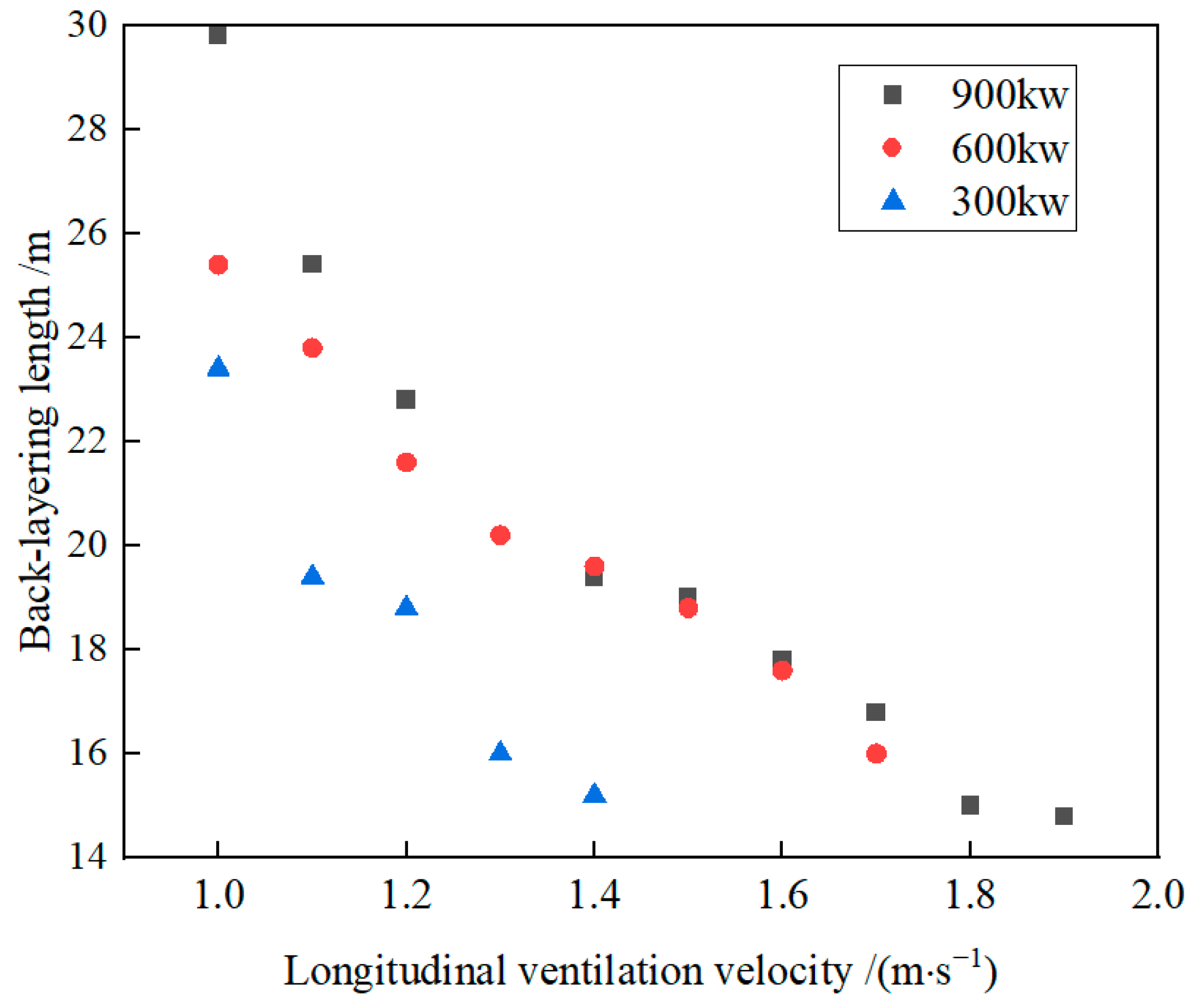

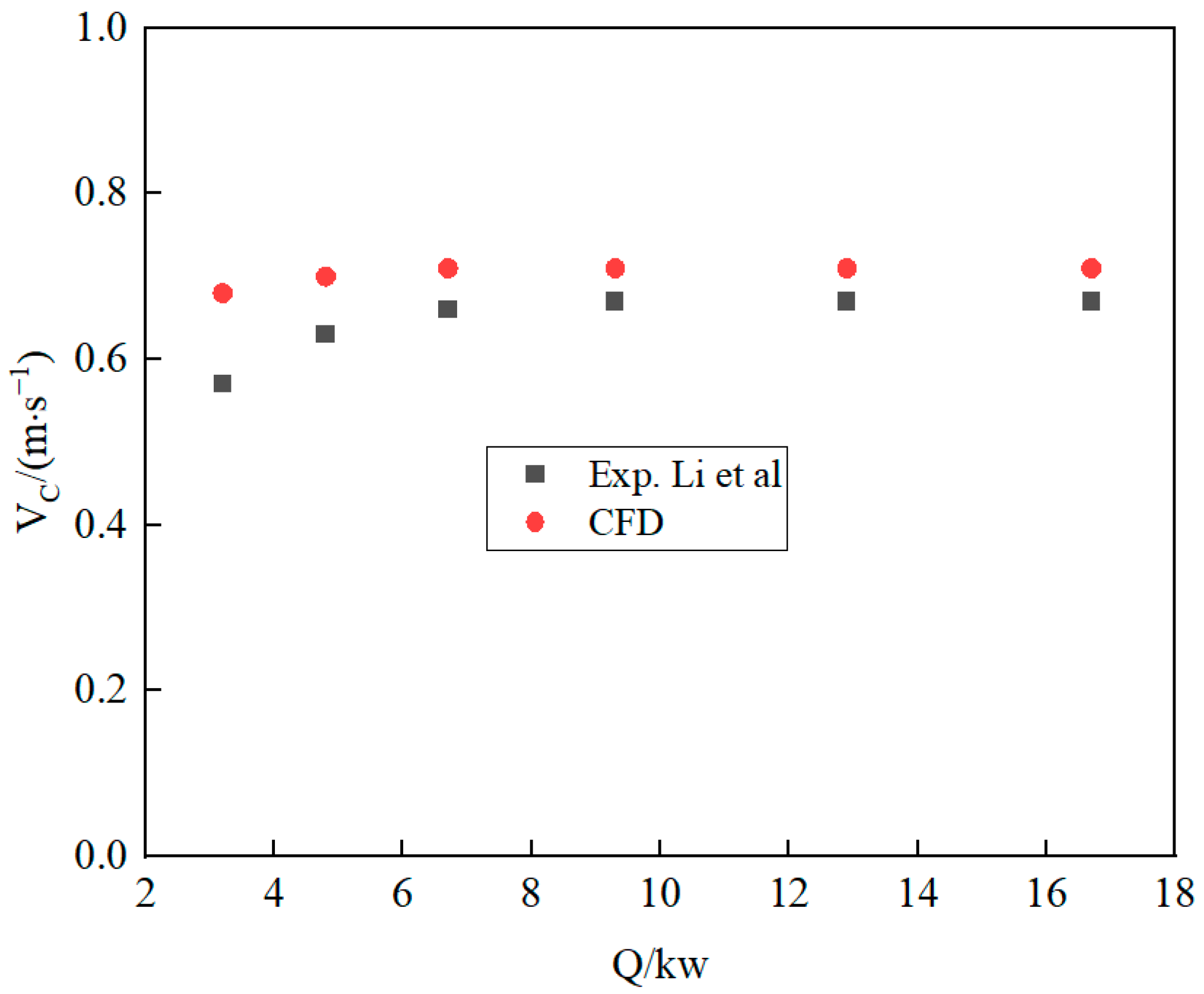
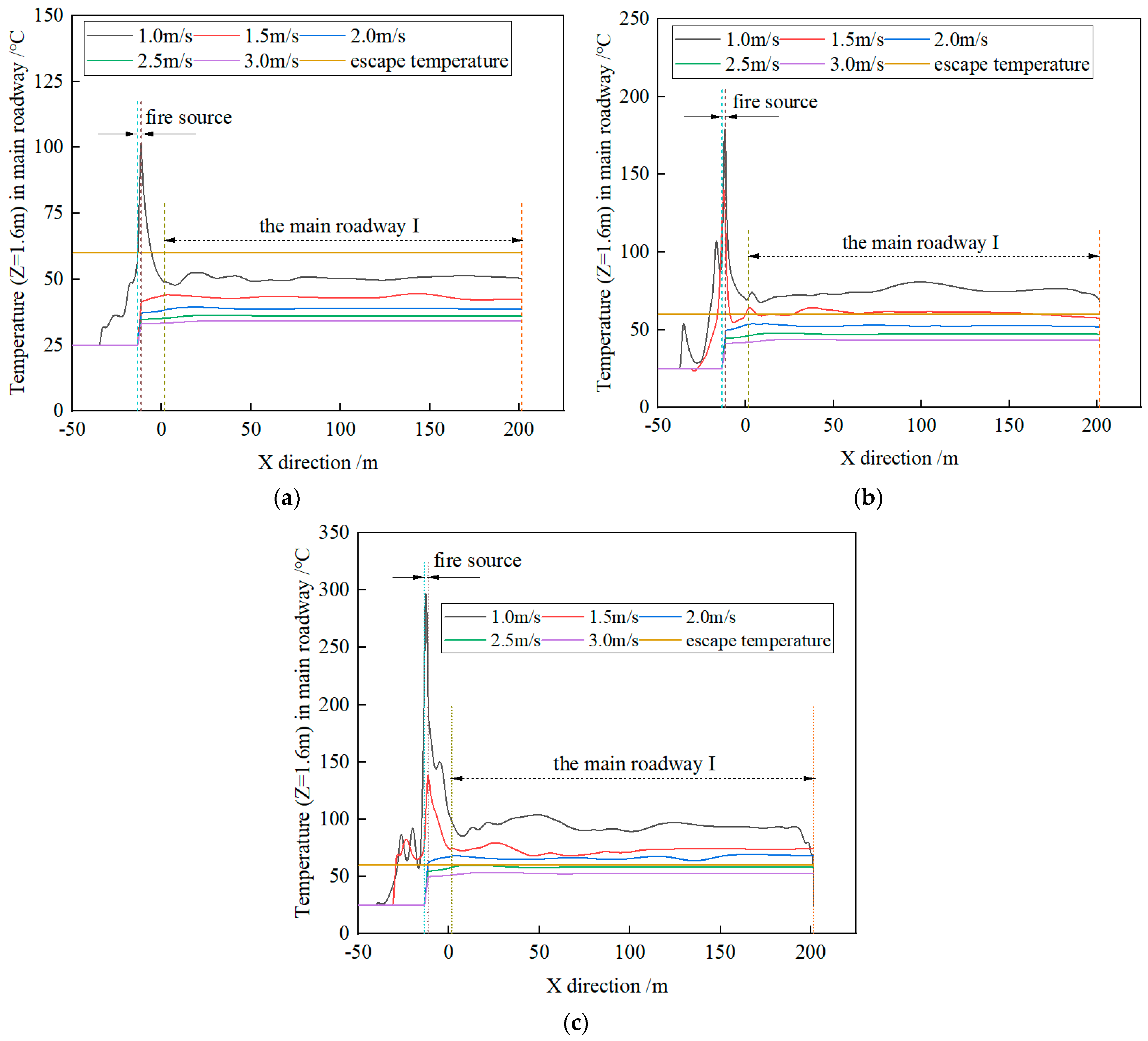



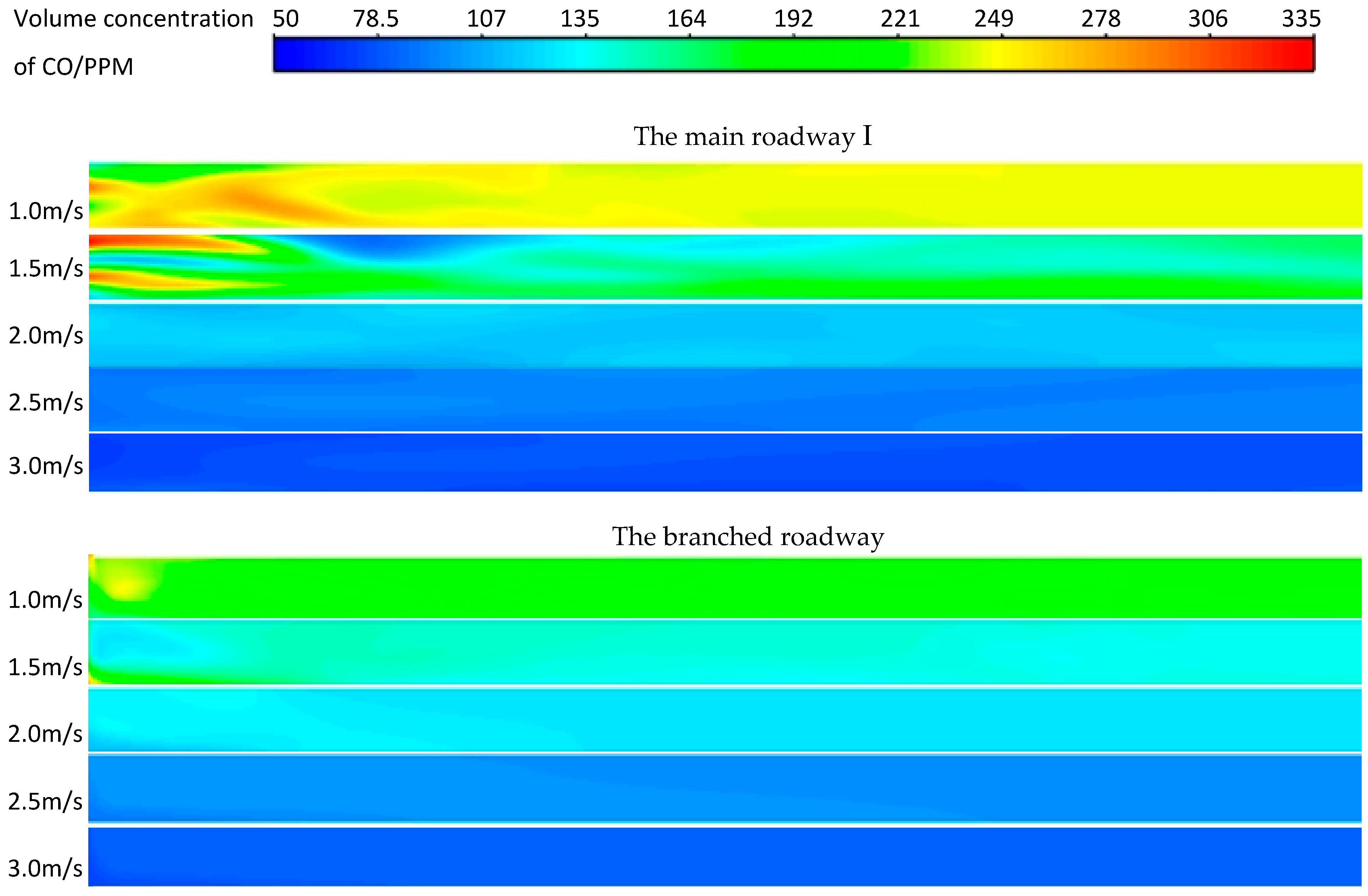

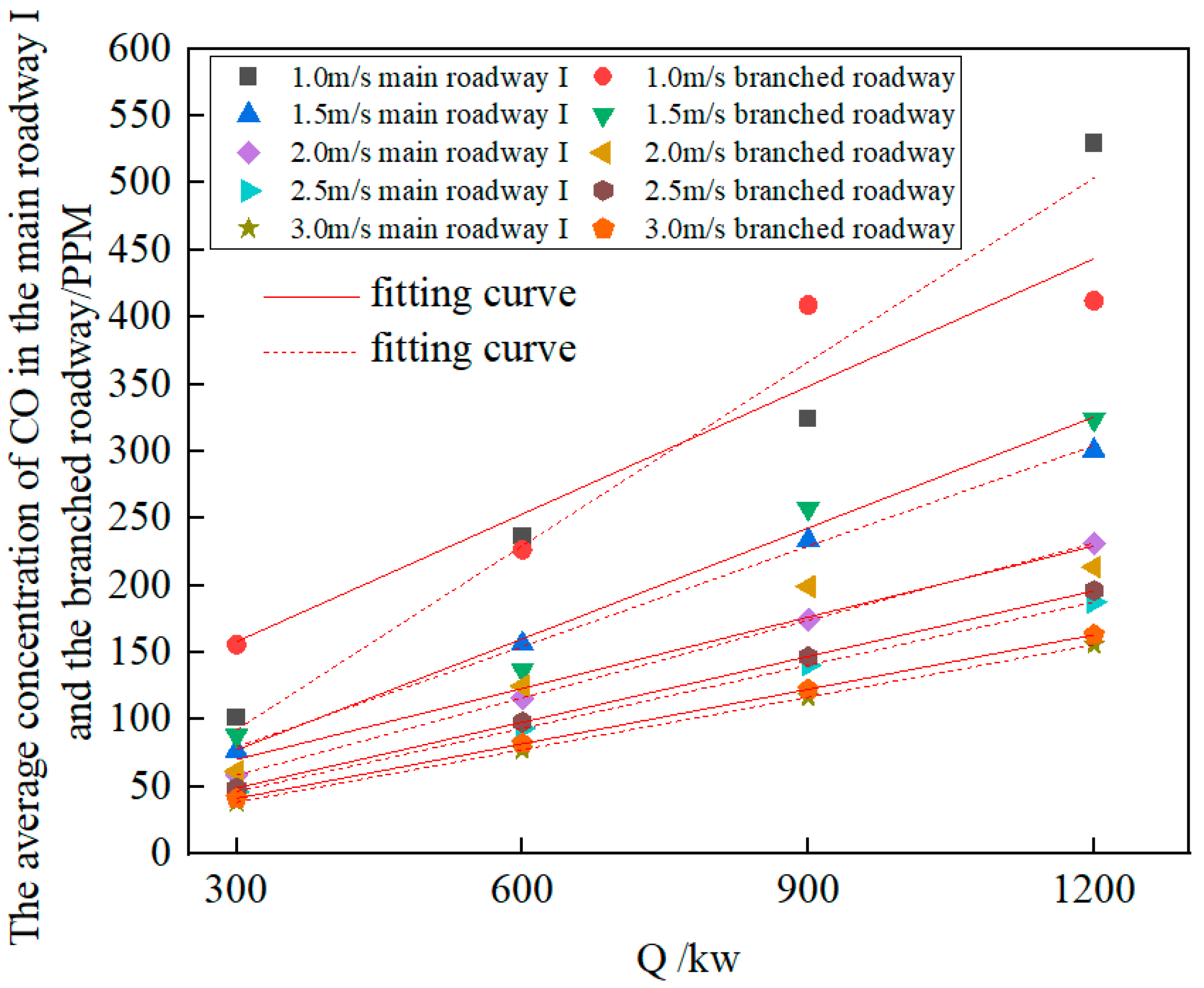
| Heat Release Rate/kw | Longitudinal Ventilation Velocity/(m·s−1) | Hydraulic Diameter/m |
|---|---|---|
| 300 | 1, 1.1, 1.2, 1.3, 1.4, 1.5, 2, 2.5, 3 | 3 |
| 600 | 1, 1.1, 1.2, 1.3, 1.4, 1.5, 1.6, 1.7, 1.8, 1.9, 2, 2.5, 3 | 3 |
| 900 | 1, 1.1, 1.2, 1.4, 1.5, 1.6, 1.7, 1.8, 1.9, 2, 2.5, 3 | 3 |
| 1200 | 1, 1.5, 2, 2.1, 2.5, 3 | 3 |
| Geometric Dimensions of Tunnels | Heat Release Rate/kw | Ambient Temperature/°C | /m·s−1 | |
|---|---|---|---|---|
| Li’s Experiment | CFD | |||
| 0.25 m × 0.25 m × 12 m | 3.2 | 20 | 0.57 | 0.68 |
| 4.8 | 20.8 | 0.63 | 0.7 | |
| 6.7 | 20.8 | 0.66 | 0.71 | |
| 9.3 | 23.3 | 0.67 | 0.71 | |
| 12.9 | 23.5 | 0.67 | 0.71 | |
| 16.7 | 24.5 | 0.67 | 0.71 | |
| The Type of Roadway | Heat Release Rate/kw | R2 | ||
|---|---|---|---|---|
| the main roadway I | 300 | 74.659 | 0.579 | 0.9892 |
| 600 | 130 | 0.808 | 0.99437 | |
| 900 | 163.280 | 0.825 | 0.98 | |
| 1200 | 242.607 | 1.013 | 0.97933 | |
| the branched roadway | 300 | 79.253 | 0.606 | 0.98865 |
| 600 | 128.951 | 0.774 | 0.99875 | |
| 900 | 179.1 | 0.859 | 0.99 | |
| 1200 | 237.95 | 0.954 | 0.9988 |
| The Type of Roadway | Ventilation Velocity/(m·s−1) | R2 | ||
|---|---|---|---|---|
| The main roadway I | 1.0 | 26.5 | 0.079 | 0.99343 |
| 1.5 | 28.3 | 0.052 | 0.99442 | |
| 2.0 | 26.25 | 0.044 | 0.9977 | |
| 2.5 | 24.9 | 0.037 | 1 | |
| 3.0 | 24.85 | 0.031 | 1 | |
| The branched roadway | 1.0 | 28.043 | 0.079 | 0.99994 |
| 1.5 | 28.81 | 0.057 | 0.99919 | |
| 2.0 | 25.555 | 0.049 | 0.99254 | |
| 2.5 | 24.92 | 0.039 | 0.99991 | |
| 3.0 | 25.205 | 0.032 | 0.99999 |
| The Type of Roadway | HRR/kw | Equation | R2 |
|---|---|---|---|
| The main roadway I | 300 | 0.99855 | |
| 600 | 0.99666 | ||
| 900 | 0.99963 | ||
| The branched roadway | 300 | 0.98718 | |
| 600 | 0.95877 | ||
| 900 | 0.99514 |
| The Type of Roadway | Ventilation Velocity/(m·s−1) | Equation | R2 |
|---|---|---|---|
| The main roadway I | 1 | 0.97318 | |
| 1.5 | 0.99836 | ||
| 2 | 0.99997 | ||
| 2.5 | 1 | ||
| 3 | 1 | ||
| The branched roadway | 1 | 0.89406 | |
| 1.5 | 0.97509 | ||
| 2 | 0.94341 | ||
| 2.5 | 0.99999 | ||
| 3 | 0.99999 |
Disclaimer/Publisher’s Note: The statements, opinions and data contained in all publications are solely those of the individual author(s) and contributor(s) and not of MDPI and/or the editor(s). MDPI and/or the editor(s) disclaim responsibility for any injury to people or property resulting from any ideas, methods, instructions or products referred to in the content. |
© 2024 by the authors. Licensee MDPI, Basel, Switzerland. This article is an open access article distributed under the terms and conditions of the Creative Commons Attribution (CC BY) license (https://creativecommons.org/licenses/by/4.0/).
Share and Cite
Ding, C.; Chang, D.; Sun, D.; Zou, S. Numerical Simulation of the Smoke Distribution Characteristics in a T-Shaped Roadway. Fire 2024, 7, 80. https://doi.org/10.3390/fire7030080
Ding C, Chang D, Sun D, Zou S. Numerical Simulation of the Smoke Distribution Characteristics in a T-Shaped Roadway. Fire. 2024; 7(3):80. https://doi.org/10.3390/fire7030080
Chicago/Turabian StyleDing, Cui, Dou Chang, Diange Sun, and Songling Zou. 2024. "Numerical Simulation of the Smoke Distribution Characteristics in a T-Shaped Roadway" Fire 7, no. 3: 80. https://doi.org/10.3390/fire7030080
APA StyleDing, C., Chang, D., Sun, D., & Zou, S. (2024). Numerical Simulation of the Smoke Distribution Characteristics in a T-Shaped Roadway. Fire, 7(3), 80. https://doi.org/10.3390/fire7030080







